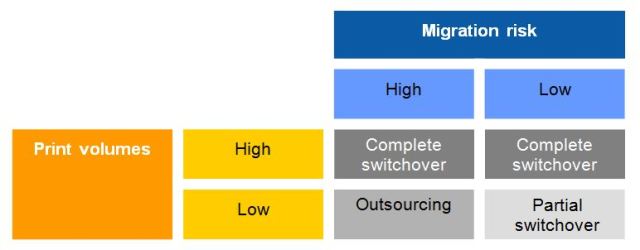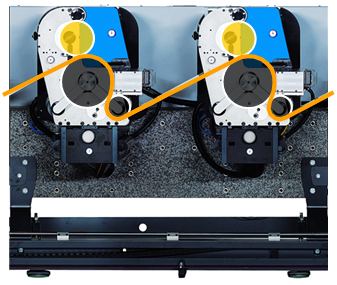In the first article in this series we explained what migration means, how it affects label printing and what risks it entails. We are now going to look at how label printers can deal with the problems posed by migration and what they need to take into account in relation to low-migration label printing. The focus in this article is on the organisational considerations involved when implementing low-migration label printing.
Low-migration label production
As we explained in the first article, the migration value of a label and the migration characteristics of packaging are difficult to determine and cannot be identified directly during label manufacture. Simple label quality controls like those used to check print register or colour are not an option. Instead, a process-based approach is required. The processes used to produce the label should rule out with almost absolute certainty any chance that harmful substances could migrate from the label to the food. This type of risk minimisation can only be achieved by examining the entire label production process – from receipt of the order through to its delivery – and eliminating all potential migration risks. There are no hard and fast rules for how to switch over to low-migration printing and implement it. However, when conducting analyses aimed at minimising risk, it generally pays to follow the value creation process.
1. Order receipt
Label printers can determine the need to take action and how relevant migration is to them by analysing the market segments and applications that they deal with. Only then can they set out the appropriate action strategies. However, regardless of the action strategy, it makes sense in the current climate for label printers drawing up a quote or offer to establish whether the relevant order involves a migration risk and whether this has been specified in sufficient detail. Standardised checklists have proven extremely useful for this purpose.

Figure 1: Possible action strategy based on print volumes and migration risk
2. Prepress
If a migration risk has been identified, a suitable production method needs to be specified. In simple terms, there are two options – minimising migration risks through the technical setup or selecting inks and auxiliary materials that, when used properly, permit correspondingly low migration values. For example, an appropriate protective coating or laminate film can be used to prevent set-off migration. If using functional barriers isn't an option, migration risks have to be reduced by selecting the correct ink system. However, it is virtually impossible to define an effective production method without a detailed description of the end product.
3. Procurement
It is also important to carefully analyse how the substrates, inks and auxiliary materials needed for production are bought in. Substances that are intended specifically for low-migration printing usually also come with their own specific requirements for processing and handling. Label printers therefore need to check in advance whether the print shop can meet the processing and handling requirements stipulated for these materials.
Furthermore, wherever possible, new production equipment also needs to be evaluated to assess whether it can help the print shop meet the requirements of low-migration printing. For example, there are clear advantages to using presses that are open and easily accessible.

Figure 2: The easily accessible flexographic printing units of the Gallus ECS 340, sleeve systems and chambered doctor blade for rapid and straightforward job changes
4. Production planning and quality assurance
There are very few instances when a label printer will consider completely switching over all production systems to low-migration printing. It is therefore crucial to ensure there is a clean separation between “standard” jobs and low-migration jobs in production planning. It is a common misconception that low-migration inks and standard inks can be processed on the same press on a job-by-job basis. Mixing inks like this will undoubtedly lead to contamination (caused by anilox rollers, path rollers, etc.) and virtually dooms any attempt at implementing low-migration printing to failure. It is therefore vital to ensure that dedicated production facilities are created. For smaller label printers in particular, this can pose a major challenge in terms of organisation and planning.
The fundamental tasks of quality assurance are largely the same in low-migration printing. However, the importance of introducing GMP (good manufacturing practices) and the resultant process and logistics adjustments should not be underestimated. In particular, a thorough analysis should be carried out to ensure consistent and complete traceability. In some cases, bringing in a specialist might be worth considering.
5. Printing and refinement, cleaning, maintenance and servicing
The decisive factors here are which materials are used, when they are used and how they come into contact with each other. Processing a low-migration job in line with prepress and production planning requirements is often the easy bit. The much bigger challenge is how to switch over and structure auxiliary processes such as cleaning, maintenance and servicing, which are usually centralised services in a print shop and can be very difficult to disentangle. For example, anilox rollers are commonly used and reused in all the different presses and cleaned in a centralised cleaning facility. What's more, label printers are seldom fully aware of the material composition of lubricants, cleaning agents, printing plates, etc. and the associated migration risks. So, besides scrutinising the actual label printing process, it is also essential to carry out a thorough analysis of auxiliary processes.
6. Order picking, storage and dispatch
The introduction of GMP also places requirements on hygiene and logistics in print shops. These include creating separate areas in storage facilities and tightening up hygiene regulations for personnel (hair nets, no smoking in production areas, hand hygiene, etc.). Hygiene requirements regarding the receipt and handover of materials and print jobs can often prove to be a real headache. As a result, when planning a concept for low-migration label production, it pays to think about docking bays for trucks and similar building measures sooner rather than later.
A holistic approach
To establish a sustainable and coherent production concept for the manufacture of low-migration labels, label printers need to adopt a holistic approach. All the production-relevant factors – people, materials and methods – need to be taken into account. As we mentioned at the start of this article, it is not possible to produce any factual evidence of freedom from migration during the actual production of labels. The only solution is to identify and eliminate potential migration risks and put in place processes that guarantee this risk minimisation on a sustainable basis. However, when pursued consistently, the switchover to low-migration printing offers the label printer an opportunity to stand out from the competition and secure a position on the market as a skilled supplier of food labels.
Please feel free to get in touch. We will be happy to help.